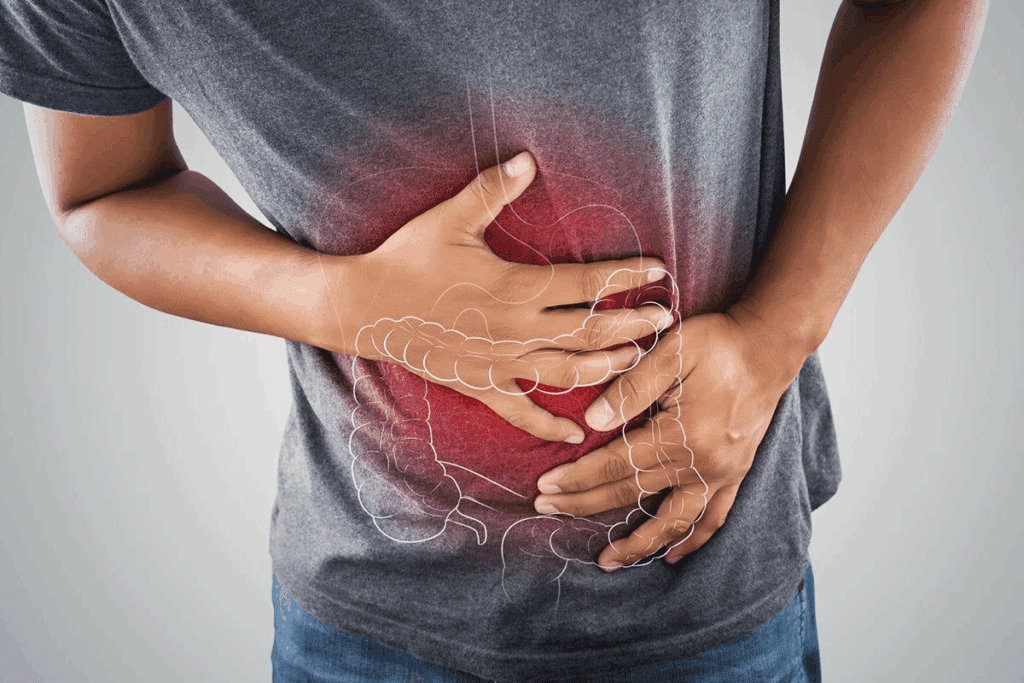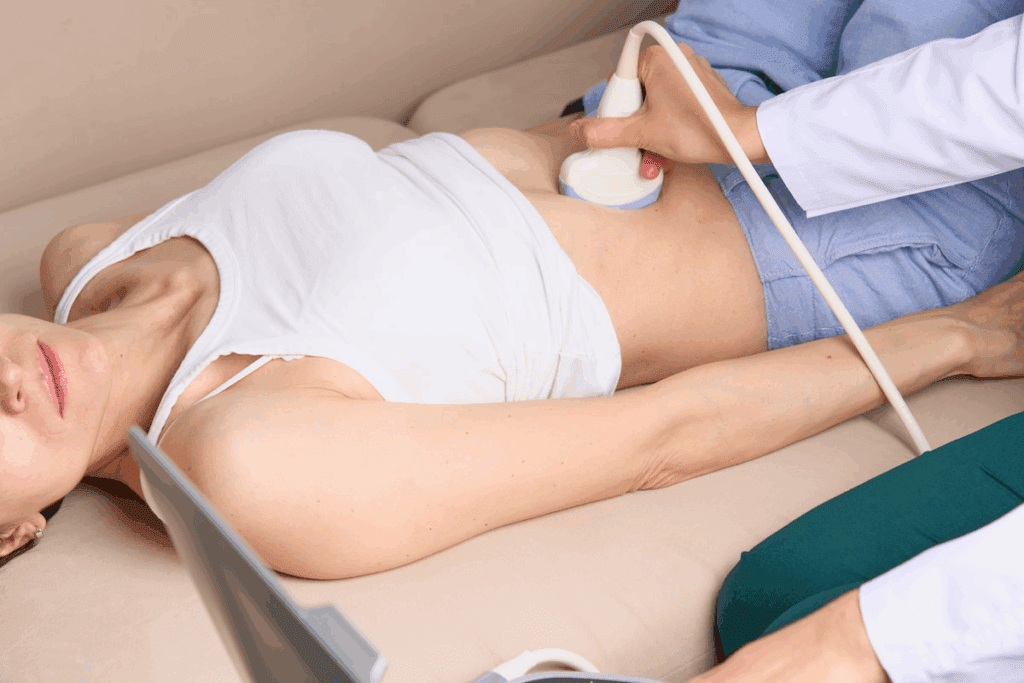Last Updated on November 26, 2025 by Bilal Hasdemir

Can you get gallstones after gallbladder surgery? Get the bad truth about why painful stones can recur in your bile ducts.
Even after the gallbladder is gone, stones can form in the bile ducts. It’s important for patients to know why this happens. This knowledge helps in finding ways to manage gallstone problems.

To understand gallstones after surgery, we must first know the biliary system. This system includes organs and ducts that make, store, and move bile. Bile is key for breaking down fats and absorbing vitamins.
The gallbladder is a small, pear-shaped organ under the liver. It stores bile until needed in the small intestine for digestion. Bile ducts carry bile from the liver to the gallbladder and then to the small intestine.
The common bile duct joins the right and left hepatic ducts. It then merges with the pancreatic duct to form the ampulla of Vater. This empties into the duodenum.
Bile is always being made in the liver and stored in the gallbladder. When food reaches the small intestine, the gallbladder releases bile into the common bile duct. This duct then carries it to the intestine.
This process is key for breaking down fats. It makes fats easier for enzymes to digest.
Gallbladder removal, or cholecystectomy, is done for gallstones causing pain or infection. The surgery removes the gallbladder but doesn’t fix the reasons for stone formation. It’s important to understand the gallbladder’s role and changes after surgery.
After surgery, the body changes how it stores and releases bile. But these changes can sometimes cause problems. This includes stones forming in the bile ducts, known as choledocholithiasis.

Gallbladder removal surgery, or cholecystectomy, doesn’t mean you’re free from gallstones. The gallbladder is a common source, but not the only one.
Even after gallbladder removal, patients can get stones in the bile ducts. This is called choledocholithiasis.
Key Facts:
About 10% of patients who have gallbladder removal surgery may get stones in the bile ducts again. This shows why it’s key to keep an eye on things after surgery.
Stones can form for many reasons, like:
Many patients don’t know they can get gallstones again after surgery. This is because of poor patient education and a common belief that removing the gallbladder means no more gallstones.
Healthcare providers need to tell patients about the chance of getting stones after surgery. This way, patients know what to look for and when to see a doctor.
Knowing the risks and symptoms helps patients manage their health better. They can get the right care if they have any problems.
Choledocholithiasis is a condition where stones form in the bile ducts, often after the gallbladder is removed. It shows how complex the biliary system is. Even without a gallbladder, stones can form.
Stones can form in the biliary system without a gallbladder due to several reasons. Altered bile flow and stasis are key factors. Bile stasis leads to the concentration of bile salts and cholesterol, making it easier for stones to form.
Bile duct stones can also form because of abnormal contraction of the sphincter of Oddi. This muscular valve controls bile flow into the intestine. If it doesn’t work right, bile stasis and stone formation risk increase.
After gallbladder removal, stones can form in different parts of the biliary system. The common bile duct and hepatic ducts are the most common sites. These areas are more prone to stone formation due to changes in bile flow after surgery.
Gallbladder stones and bile duct stones have similarities but also differences. Gallbladder stones are formed in the gallbladder and are usually cholesterol or pigment stones.
Bile duct stones, by contrast, form in the bile ducts. They can be primary (formed in situ) or secondary (originating from the gallbladder). The composition and formation mechanisms of bile duct stones differ from gallbladder stones.
Knowing when gallstones might come back after surgery is key for patients. The chance of getting stones again is a big worry. Knowing when this might happen helps both patients and doctors take steps to prevent it.
The first three years after surgery are very important. Studies show that the risk of getting stones again is highest during this time. It’s important to watch closely during these years to catch any problems early.
Close monitoring means regular check-ups and maybe special imaging tests. These help find stones forming in the bile ducts early on.
Even though the risk is highest in the first three years, it doesn’t go away completely. Patients can keep getting stones, but at a lower rate, after that.
A long-term risk assessment is part of follow-up care for those who’ve had surgery. This looks at the patient’s health, diet, and family history.
Several things can change when stones might come back. These include:
Knowing these factors helps manage the risk of getting stones again.
| Factor | Influence on Stone Recurrence |
| Dietary Habits | A diet high in fat and low in fiber can increase the risk. |
| Genetic Predisposition | A family history of gallstones can increase an individual’s risk. |
| Metabolic Conditions | Conditions like diabetes and obesity can affect bile composition and increase risk. |
By understanding when stones might come back and what affects it, patients and doctors can work together. This helps lower risks and manage symptoms better.
It’s important to know how gallbladder surgery changes the body. Removing the gallbladder changes how bile moves and works in the body.
The gallbladder stores bile and releases it when needed. Without it, bile flows more continuously into the intestine. This can lead to stones in the bile ducts.
The sphincter of Oddi controls bile flow. After surgery, it must work right to stop bile from going back to the liver or getting stuck in the ducts. This helps prevent stones.
Small parts of the biliary system might stay after surgery. These can be nuclei for stone formation. They, along with changes in bile, raise the risk of stones, even without a gallbladder.
In summary, knowing about these changes helps manage and prevent stones after gallbladder removal. Patients should know that anatomical changes can lead to stone formation even without a gallbladder. This shows why follow-up care is so important.
Several factors can increase the risk of getting stones without a gallbladder. These include medical history and lifestyle choices. Knowing these risks helps both patients and doctors prevent and watch for problems.
Having had many gallstones before surgery is a big risk factor. People with a history of multiple gallstones are more likely to get stones in the bile ducts later. This is because the same conditions that caused the gallstones are likely to remain.
Family history is key in gallstone development. Those with a family history of gallstones are more at risk, even after surgery. Genetics can affect bile composition and stone formation.
Metabolic conditions like obesity, diabetes, and high cholesterol raise gallstone risk. These conditions change bile composition, leading to stones. Managing these conditions through diet and treatment can lower the risk.
Diet and lifestyle also play a part in gallstone risk. Eating a lot of fat, cholesterol, and refined carbs increases risk. A sedentary lifestyle and quick weight loss also contribute to gallstones.
Understanding these risk factors helps patients and doctors prevent stones after gallbladder surgery. This may involve changing diet, managing metabolic conditions, and regular monitoring for signs of stones.
It’s important to know the symptoms of post-cholecystectomy stones. This is true for those who have had their gallbladder removed. They should watch for signs that might mean they have bile duct stones.
Bile duct stones can cause a lot of symptoms. These include pain in the right upper abdomen, jaundice, and fever. The pain might spread to the back.
Jaundice makes the skin and eyes turn yellow because of blocked bile flow. Fever can happen if there’s an infection.
After gallbladder removal, symptoms of bile duct stones can be different. Some people might feel similar pain, while others might not feel anything at all. The pain’s location and how bad it is can change, and some might notice dark urine or pale stools.
Some symptoms need to be seen by a doctor right away. These include severe pain, high fever, and jaundice. Seek emergency care if you have these symptoms. They could mean serious problems like cholangitis or pancreatitis.
Untreated bile duct stones can cause big problems. These include cholangitis, pancreatitis, and secondary biliary cirrhosis. It’s key to treat bile duct stones quickly to avoid these issues and keep patients safe.
It’s vital for patients to know the signs of post-cholecystectomy stones. If they notice these symptoms, they should get medical help right away. Knowing these signs can help catch problems early and prevent serious issues.
It’s important to catch recurrent stones early. This is true for people who had their gallbladder removed. They can get bile duct stones too, so finding them quickly is key.
Advanced imaging is a big help in finding stones again. Here are some ways:
Labs play a big part in diagnosing stones again. Here are some important tests:
If you have symptoms like these, see a doctor right away:
Getting checked out fast can help find and treat stones early. This can prevent bigger problems.
Dealing with recurrent gallstones can be tough. But, there are many modern treatments available. The right treatment depends on several things. These include the stone’s size and location, the patient’s health, and any complications.
ERCP is a top choice for removing bile duct stones. A flexible tube with a camera goes through the mouth to the bile duct. Then, tools remove or extract the stones.
Benefits of ERCP: It’s a small procedure with a high success rate and quick recovery. Potential Risks: It can cause pancreatitis, bleeding, and infection.
Surgery might be needed for some cases of recurrent gallstones. This could include removing the gallbladder’s parts or fixing bile duct damage.
For those not suited for surgery or endoscopy, medical dissolution therapy is an option. It uses medicines to break down the gallstones.
| Therapy Type | Description | Success Rate |
| Oral bile acids | Dissolves cholesterol stones | Moderate |
| Contact dissolution | Direct infusion of solvent into the bile duct | High |
Scientists are always looking for new ways to treat gallstones. They’re working on new dissolution agents and better imaging techniques. These could lead to better diagnosis and treatment.
Knowing about these treatments helps both patients and doctors make better choices for managing gallstones.
After having your gallbladder removed, you can lower the chance of getting new gallstones. Knowing how to prevent them is key. There are many ways to do this.
Your diet is very important in preventing gallstones from coming back. Eating less fat is a good start. Also, eating more fiber from fruits, veggies, and whole grains helps with digestion.
Drinking lots of water is also important. It helps with digestion and stops bile from getting too concentrated. This can help prevent stones from forming.
Some medicines can help stop gallstones from coming back. Ursodeoxycholic acid (UDCA) is one. It can dissolve small stones and stop new ones. But, always talk to your doctor before taking it.
If you’re at high risk for gallstones, seeing your doctor regularly is a must. They might do tests to check for new stones.
Getting care from a team of doctors is best. Gastroenterologists, surgeons, and primary care doctors can help. They can guide you on diet, lifestyle, and any needed medicine to prevent gallstones.
By following these prevention tips and staying in touch with your healthcare team, you can greatly lower your risk of getting new gallstones after surgery.
Gallstone recurrence after cholecystectomy is a big worry for those who’ve had their gallbladder removed. It’s important to know that getting gallstones again is possible. This knowledge helps in managing and preventing it.
Even after the gallbladder is gone, the risk of gallstones coming back is real. Things like a history of gallstones, family ties, and certain health issues can up this risk. These factors can lead to stones forming in the bile ducts.
Knowing the signs and risks is key for patients to get help quickly. There are advanced ways to find and treat gallstones again. These include endoscopic methods and medicines to dissolve stones.
Preventing gallstones from coming back is also important. This can be done through diet changes and regular check-ups. By understanding the risks and taking action, patients can lower their chances of getting gallstones again.
Yes, it’s possible to get gallstones after your gallbladder is removed. This is called choledocholithiasis or bile duct stones.
About 10% of people get gallstones again after surgery. But many don’t know this can happen.
If you had many gallstones before, or if your family has a history of them, you’re at higher risk. Metabolic conditions and your diet also play a part.
Stones can form in the bile ducts because of changes in how bile flows. Biliary remnants and other factors also contribute.
Symptoms include pain in your abdomen and jaundice. These can be different from the pain you felt before surgery.
Doctors use advanced imaging and lab tests to find stones in the bile ducts. They also look for biomarkers.
Treatment includes endoscopic procedures and surgery. There are also medical therapies and new approaches being explored.
Yes, you can prevent them. Changing your diet and taking certain medications can help. Regular check-ups are also important for those at high risk.
Gallstones can come back within the first three years after surgery. But the risk stays high over time.
No, they are different. Bile duct stones have their own characteristics and ways of forming.
Yes, it’s possible to get gallstones without a gallbladder. Stones can form in the bile ducts.
Choledocholithiasis is when stones are in the bile ducts. It can happen after your gallbladder is removed.
Yes, it’s possible to get gallstones after surgery. This shows why it’s important to be aware and take steps to prevent them.
The sphincter of Oddi controls bile flow. If it doesn’t work right, it can lead to stone formation.
Yes, changing your diet can help prevent gallstones from coming back. It’s a good way to reduce your risk.
Garg, P. K., Venkatachalam, U., & Tandon, R. K. (1995). Cholesterol bile duct stones with no stones in the gallbladder. Gastroenterology, 20(4), 296-299. https://pubmed.ncbi.nlm.nih.gov/7665818/
Subscribe to our e-newsletter to stay informed about the latest innovations in the world of health and exclusive offers!